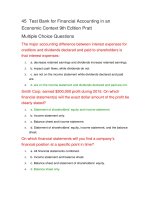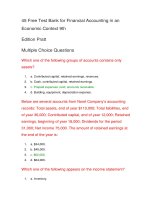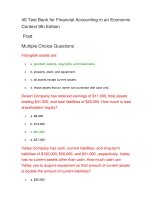63 test bank for financial accounting in an economic context 8th đề thi trắc nghiệm có đáp án
Bạn đang xem bản rút gọn của tài liệu. Xem và tải ngay bản đầy đủ của tài liệu tại đây (69.29 KB, 16 trang )
63 Test Bank for Financial Accounting in an Economic
Context 8th
Edition by Pratt Multiple Choice Questions-Page 1
The cash paid during the year to satisfy a company’s debt is found
in its
1.
a. statement of cash flows.
2.
b. income statement.
3.
c. statement of shareholders’ equity.
4.
d. auditor’s report.
Dividends declared and paid to the owners are found in the
1.
a. management letter.
2.
b. income statement.
3.
c. dividends statement.
4.
d. statement of shareholders’ equity.
A company’s profits during its most recent year are found in its
1.
a. balance sheet and income statement.
2.
b. statement of cash flows only.
3.
c. statement of shareholders’ equity only.
4.
d. income statement and statement of shareholders’ equity.
The retained earnings section of the statement of shareholders’
equity communicates
1.
a. beginning balance plus income less dividends.
2.
b. revenues less expenses during a period of time.
3.
c. how much cash that management has paid for bonuses.
4.
d. operating, investing, and financing activities.
An explanation about the assumptions, estimates, and choices of
alternative accounting methods used in the financial statements is
found in the
1.
a. footnotes to the balance sheet.
2.
b. auditor’s report.
3.
c. statement of shareholders’ equity.
4.
d. president’s letter to the shareholders.
A statement that financial statement information “is the
responsibility of the company” issuing the statements is found in
the
1.
a. footnotes to the financial statements.
2.
b. loan contract.
3.
c. management letter.
4.
d. board of directors’ report.
The income statement communicates
1.
a. assets, liabilities, and shareholders’ equity as of a certain date.
2.
b. how much cash the owner received during the period.
3.
c. information about dividends the company paid to its owners.
4.
d. revenues less expenses during a period of time.
An equity investor is
1.
2.
3.
a. a person who provides money to a company with the expectation that it will
be paid back with interest.
b. a creditor that has a regular trade relationship.
c. a person who provides money to a company as a gift with a stipulation that
it will be used as agreed.
4.
d. a person who provides money to a company, though the original money
never has to be repaid, and who may be entitled to receive periodic cash
payments.
The board of directors
1.
a. provides money to a company with the expectation that it will be paid back
with interest.
2.
b.makes corporate decisions such as hiring and firing management and
setting company policy.
3.
c.is responsible for the future profits of a company.
4.
d. is in charge of accounting and human resources on a daily basis.
Who prepares financial reports for a particular company?
1.
a.The Securities and Exchange Commission
2.
b.The Board of Directors
3.
c.The company’s management
4.
d.The company’s auditors.
The balance sheet communicates
1.
2.
a.proof to the investor that the company is profitable.
b. assets, liabilities, and shareholders’ equity with all transactions reflected
through the year.
3.
c. assets, liabilities, and shareholders’ equity as of a certain date.
4.
d. operating, investing, and financing activities.
An internal control system
1.
a.is maintained to ensure that transactions of a company are properly
recorded and reported and the assets are safeguarded.
2.
b.is included in the set of footnotes to the financial statements.
3.
c.is an estimate of the profits a company expects to earn in the future.
4.
d.measures how much control management has over its staff.
A debt investor is
1.
a. a person who provides money to a company with the expectation that it will
be paid back with interest.
2.
b. a person who provides money to a company and expects periodic cash
payments in return, though the original money never has to be repaid.
3.
c. a person who provides money to a company as a gift with a stipulation that
it will be used as agreed.
4.
d. often referred to as a stockholder.
Footnotes to financial statements
1.
a.more fully explain certain items in the financial statements.
2.
b.reflect financial notes personalized by the company’s executive team.
3.
c.show the detail of salaries of every employee.
4.
d.justify fraudulent business practices.
As a potential creditor, you are interested in a company’s ability to
pay loan interest and principal as they come due. Which of the
following would be of the greatest interest to you in your analysis?
1.
a. statement of shareholders’ equity.
2.
b. income statement.
3.
c. statement of cash flows.
4.
d. Statement of Financial Accounting Standards.
Where would you find information on the amount of net income for
the year?
1.
a.Factory production reports on units produced
2.
b.Auditor’s report
3.
c.Income statement
4.
d.Internal Revenue Service
Liabilities may be described as
1.
a. amounts that will be used for future growth.
2.
b. the amounts owed that must be paid in the future.
3.
4.
c.the total measured past growth of a firm less the amount distributed to the
owners.
d.amounts the company paid during the past year.
Which one of the following statements is true?
1.
a.Financial accounting is the only accounting used in the United States.
2.
b.Companies that have a profit objective use not-for-profit accounting.
3.
c. Managerial accounting targets operating decisions.
4.
d. Financial and tax accounting are virtually the same.
Considering and understanding how business decisions affect the
financial statements is
1.
a.the sole responsibility of the Securities and Exchange Commission.
2.
b.provided in the auditor’s report.
3.
c.referred to as an economic consequence perspective.
4.
d.interpreted strictly by the company’s suppliers.
An investor wants to find the amount of cash and land that a
company has. Where will the investor look?
1.
a. Statement of shareholders’ equity
2.
b. Income statement
3.
c. Balance sheet
4.
d. Statement of cash flows.
A Certified Public Accountant
1.
a.reviews every transaction that a company conducts during any given year.
2.
b.performs a company’s audit.
3.
c.is one of the investors of a company.
4.
d.is responsible for the preparation and integrity of a company’s financial
statements.
The amount which a company’s customers owe the company for
products delivered or services rendered is found in the
1.
a. footnotes only.
2.
b. income statement.
3.
c. balance sheet.
4.
d. statement of cash flows.
Public stock exchanges
1.
a. are operated by managers of a company.
2.
b. are markets that sell annual reports.
3.
4.
c. provide a forum for buying and selling of equity interests in other
companies.
d. are used to evaluate debt and equity investments.
Retained earnings may be described as
1.
a. the total past profits retained in the business.
2.
b. a company’s future growth.
3.
c. the amount invested in the firm by its owners.
4.
d. amounts retained for payments to vendors.
Solvency may be described as
1.
a. an amount owed that must be paid in the future.
2.
b. amounts that can be distributed to owners only.
3.
c. the amount invested in the firm by its owners.
4.
d. the ability to generate enough cash to pay its debt as the amounts become
due.
Cash received by a company from its regular operations during the
year is found in its
1.
a. balance sheet.
2.
b. statement of cash flows.
3.
c. statement of shareholders’ equity.
4.
d. auditor’s report.
The statement of cash flows communicates
1.
a. assets, liabilities, and owners’ equity at a point of time.
2.
b. operating, investing, and financing activities.
3.
c. beginning balance plus income less dividends.
4.
d. how much cash the company owes its employees.
CPA is an abbreviation for
1.
a. Certified Public Accountant.
2.
b. Certified Production Accountant.
3.
c. Consumer Protection Agency.
4.
d. Certified Permissible Accounting.
A statement that “the financial statements were prepared in
accordance with generally accepted accounting principles” is found
in the
1.
a. collateral.
2.
b. stock market.
3.
c. footnotes to the balance sheet.
4.
d. auditor’s report.
To run a company effectively, which one of the following might be a
source from which management might acquire capital?
1.
a.Customers
2.
b.FASB
3.
c.Debt and equity investors
4.
d.Auditors
63 Free Test Bank for Financial Accounting in an
Economic Context 8th Edition by Pratt Multiple Choice
Questions-Page 2
Ownership of an equity security entitles the holder to which basic
right?
1.
a. The right to management outstanding loans.
2.
b. The right to pay dividends.
3.
c. The right to vote for company directors at the annual shareholders' meeting.
4.
d. The right to certify financial report reviews.
Financial accounting practices and standards used in other
countries
1.
a.are the same as practices used by United States companies.
2.
b.have different systems of financial accounting.
3.
c.are more progressive than those used by United States companies.
4.
d.will often have common practices similar to U.S. GAAP.
The advantage to the user of financial accounting statements that
are audited by independent certified public accountants is
assurance that the
1.
a. statements are produced in accordance with generally accepted accounting
principles.
2.
b. company will be solvent for at least one more year.
3.
c. company cannot remain profitable for more than 2 to 3 years.
4.
d. company pays its fair share of income taxes.
Which of the following factors is least likely to encourage managers
and auditors to act professionally?
1.
a. professional reputation.
2.
b. tax structure
3.
c. legal liability
4.
d. ethics.
Which of the following groups make up a company’s audit
committee?
1.
a. Auditors.
2.
b. Outside directors from the Board.
3.
c. Company officers.
4.
d. All of the individuals in (a), (b), and (c) are included in the audit committee.
All of the following are false regarding international accounting
standards (IAS) except which of the following?
1.
a. The SEC requires all companies to use IAS.
2.
b. There are no substantive differences between U.S. GAAP and IFRS.
3.
c. The SEC prohibits U.S. stock exchanges from listing non-U.S. companies
who follow IFRS.
4.
d. All public companies in the European Union are required to report using
IFRS and IAS.
Generally accepted accounting principles
1.
a.are laws created and enacted by Congress.
2.
b.define the standards for internal management reporting.
3.
c.increase the level of credibility in financial statements.
4.
d.are created by the Securities and Exchange Commission.
What encourages management to refrain from pressuring auditors
too strongly?
1.
a. Possible legal liability
2.
b. Outside investors and creditors
3.
c. Prospects of higher net income
4.
d. Economic incentives from outsiders.
Generally accepted accounting principles are determined by
1.
a. annual voting by all certified public accountants.
2.
b. a privately financed body known as the FASB.
3.
c. the SEC.
4.
d. a congressional committee that passes laws governing accounting practice.
International Financial Reporting Standards (IFRS) are promulgated
by
1.
a.the United Nations.
2.
b.the World Bank.
3.
c.the Big Four accounting firms.
4.
d.the IASB.
Annual reports of public companies
1.
a.are published once per year.
2.
b.include financial statements adjusted for inflation.
3.
c.are also known as Form 10-K.
4.
d.are published by companies 4 times per year.
Which of the following is least likely to be a by-product of ethical
business practices?
1.
a. fewer lawsuits.
2.
b. higher profits.
3.
c. higher audit fees.
4.
d. public trust.
International Financial Reporting Standards (IFRS) are recognized
as acceptable by major stock exchanges throughout the world
except in
1.
a.England.
2.
b.Japan.
3.
c.The United States.
4.
d.France.
Which of the following statements is true?
1.
a. Dividend payments are determined by management.
2.
b. Dividend payments are specified by a contract.
3.
c. Dividend payments are based on company collateral.
4.
d. Dividend payments are paid at the board of director's discretion.
Shareholders
1.
a.and employees are the owners of a company.
2.
b.receive repayment of the cash they have invested in a business.
3.
c.receive payment from a company regardless if the company is profitable or
not.
4.
d.may benefit from increases in the value of their investment of a company.
Select the name that doesn’t fit with the others on the list.
1.
a. PricewaterhouseCoopers
2.
b. Sarbanes-Oxley
3.
c. Deloitte & Touche
4.
d. KPMG Peat Marwick.
All of the following might be found in the auditor's report except:
1.
2.
3.
a. A statement about conformity with GAAP.
b. A statement about the fair presentation of the financial conditions and
operations of
the audited company.
4.
c. A statement about the effectiveness of the company's internal control
system.
5.
d. A statement about the function of the company's board of directors.
Which of the following is a public exchange for equity and debt
securities?
1.
a. The Federal Trade Commission.
2.
b. The New York Stock Exchange.
3.
c. The Securities and Exchange Commission.
4.
d. The Financial Accounting Standards Board.
GAAP is an acronym for
1.
a. General Asset Accounting Procedures.
2.
b. Government Agency Accounting Procedures.
3.
c. Generally Accepted Accounting Principles.
4.
d. Global Accounting Activity Principles.
All of the following would likely be part of a loan contract except:
1.
a. maturity date
2.
b. earning power
3.
c. collateral
4.
d. annual interest.
Which one of the following is true concerning the International
Accounting Standards Board?
1.
a.It is the international accounting standards setting body that is attempting to
bring greater uniformity to worldwide accounting practices.
2.
b.It approves all financial statements before they are distributed to users.
3.
c.It consistently disagrees with the FASB on its rulemaking.
4.
d.It requires both national and international companies around the world apply
the same accounting principles.
Which of the following best describes the two perspectives of the
financial reporting process that managers need to understand in
investing decisions?
1.
a. Economic consequences and user orientation.
2.
b. Corporate governance and user orientation.
3.
c. User orientation and debt covenants.
4.
d. Economic consequences and corporate governance.
Equity investments are bought and sold
1.
a.only on the first day of each year.
2.
b.in stock exchanges such as the NASDAQ.
3.
c.by a company’s independent auditors.
4.
d.from and to the SEC.
When management goes beyond ethical boundaries in its attempt
to make financial statements appear attractive, management
1.
a.should be commended for its creativity.
2.
b.will not need an annual audit.
3.
c.should pay its employees larger bonuses.
4.
d.is perpetrating fraud or possible criminal activity.
Which of the following is a measure of past profits that have been
retained in a business?
1.
a liabilities
2.
b. common stock.
3.
c. retained earnings.
4.
d. assets.
Debt investments
1.
a.require payments to the shareholders for periodic dividends.
2.
b.are found on a company’s income statement.
3.
c.may be secured with collateral.
4.
d.return payments at the discretion of the board of directors.
Where would you most likely find a detailed explanation about
estimates used in the financial statements of a company?
1.
a. management letter
2.
b. financial footnotes
3.
c. debt restrictions
4.
d. debt contracts.
All of the following are functions of the board of directors except:
1.
a. Attending quarterly meetings.
2.
b. Conducting performance review for management.
3.
c. Declaring dividends.
4.
d. Firing staff personnel.
The auditors are charged with responsibility
1.
a.to detect financial fraud committed by employees during the course of their
audit
2.
b.to conduct a thorough and independent audit
3.
c.to correct all errors in the financial statements
4.
d.for the accuracy and completeness of the financial statements
The independence of the auditor is subject to question when the
1.
a. auditor is paid by the management of the company being audited.
2.
b.auditor is independent.
3.
c.audit firm is also responsible for preparing the tax return.
4.
d. auditor is paid 1% of the company’s profits for the audit services provided.
Which of the following best describes assets paid to owners of a
company as a return for their initial investment?
1.
a. payables
2.
b. compensation contracts
3.
c. dividends
4.
d. interest.
Which of the following groups enacted the Sarbanes Oxley Act?
1.
a. FASB
2.
b. AICPA
3.
c. U.S. Congress
4.
d. PCAOB.
Which of the following statements is true?
1.
a. Shopping for favorable audit opinions is permitted by the SEC.
2.
b. No formal reporting of auditor switches is required by the SEC.
3.
c.The SEC has enacted rules to help ensure financial literacy among audit
committee members.
4.
d.Since management constructs the financial statements, auditors have no
legal liability to those who rely upon these reports.









